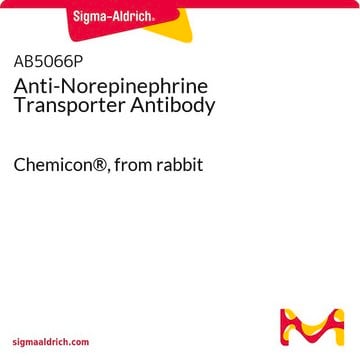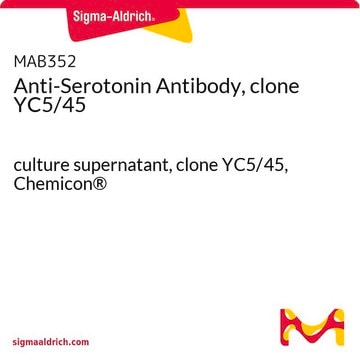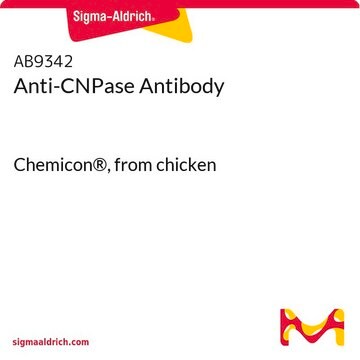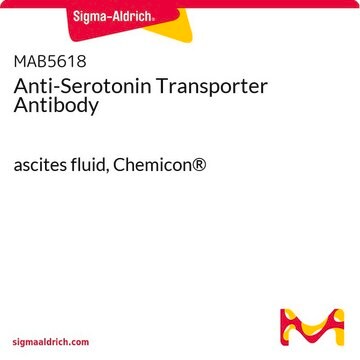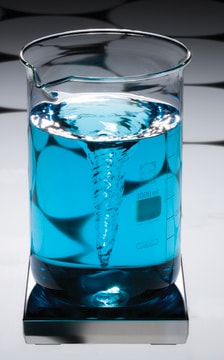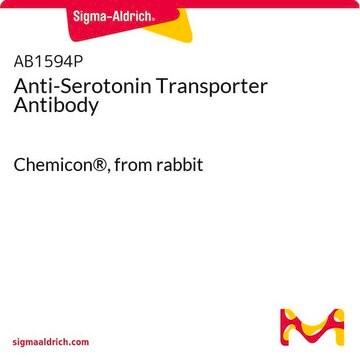MAB5620
Anti-Norepinephrine Transporter Antibody
ascites fluid, Chemicon®
Synonym(s):
NET
Sign Into View Organizational & Contract Pricing
All Photos(1)
About This Item
UNSPSC Code:
12352203
eCl@ss:
32160702
NACRES:
NA.41
Recommended Products
biological source
mouse
Quality Level
antibody form
ascites fluid
antibody product type
primary antibodies
clone
monoclonal
species reactivity
human, monkey
manufacturer/tradename
Chemicon®
technique(s)
immunohistochemistry: suitable
isotype
IgG
NCBI accession no.
UniProt accession no.
shipped in
dry ice
target post-translational modification
unmodified
Gene Information
human ... SLC6A2(6530) , SLC6A5(9152)
Specificity
Norepinephrine Transporter, human and non-human primate.
Immunogen
Synthetic peptide from human norepinephrine Transporter.
Application
Detect Norepinephrine Transporter using this Anti-Norepinephrine Transporter Antibody validated for use in IH.
Legal Information
CHEMICON is a registered trademark of Merck KGaA, Darmstadt, Germany
Not finding the right product?
Try our Product Selector Tool.
Storage Class Code
10 - Combustible liquids
WGK
WGK 1
Flash Point(F)
Not applicable
Flash Point(C)
Not applicable
Certificates of Analysis (COA)
Search for Certificates of Analysis (COA) by entering the products Lot/Batch Number. Lot and Batch Numbers can be found on a product’s label following the words ‘Lot’ or ‘Batch’.
Already Own This Product?
Find documentation for the products that you have recently purchased in the Document Library.
M Neukirchen et al.
British journal of anaesthesia, 109(6), 887-896 (2012-09-05)
Intraoperative hypotension is associated with increased risk of perioperative complications. The N-methyl-d-aspartate (NMDA) receptor (NMDA-R) antagonist xenon (Xe) induces general anaesthesia without impairment of cardiac output and vascular resistance. Mechanisms involved in cardiovascular stability have not been identified. Muscle sympathetic
Yazan Haddad et al.
Journal of nanobiotechnology, 18(1), 95-95 (2020-07-15)
Currently, the diagnosis and treatment of neuroblastomas-the most frequent solid tumors in children-exploit the norepinephrine transporter (hNET) via radiolabeled norepinephrine analogs. We aim to develop a nanomedicine-based strategy towards precision therapy by targeting hNET cell-surface protein with hNET-derived homing peptides.
Jennifer E Gains et al.
European journal of nuclear medicine and molecular imaging, 45(3), 402-411 (2017-10-19)
Neuroblastoma may be treated with molecular radiotherapy, 131I meta-Iodobenzylguanidine and 177Lu Lutetium DOTATATE, directed at distinct molecular targets: Noradrenaline Transporter Molecule (NAT) and Somatostatin Receptor (SSTR2), respectively. This study used immunohistochemistry to evaluate target expression in archival neuroblastoma tissue, to
Isabel Pérez-Santos et al.
Cerebral cortex (New York, N.Y. : 1991), 31(9), 4115-4139 (2021-05-19)
Noradrenaline (NA) in the thalamus has important roles in physiological, pharmacological, and pathological neuromodulation. In this work, a complete characterization of NA axons and Alpha adrenoceptors distributions is provided. NA axons, revealed by immunohistochemistry against the synthesizing enzyme and the
Our team of scientists has experience in all areas of research including Life Science, Material Science, Chemical Synthesis, Chromatography, Analytical and many others.
Contact Technical Service